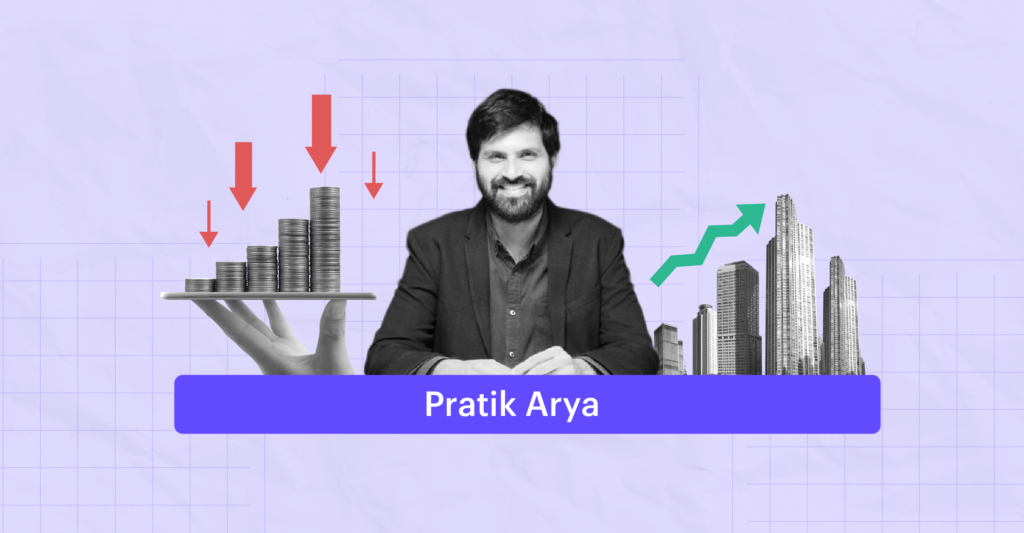Last Updated on Oct 14, 2022 by Aradhana Gotur
Growth stocks generally trade at high P/E as analysts extrapolate current growth rates way into the future. Currently, there is mayhem in growth stocks across the world, be it US tech companies, NASDAQ or listed “New-Age” companies in India. The bubble burst at the first sign of a changing interest rate environment.
Growth stocks – business and valuation characteristics
Growth stocks like start-ups have two typical business characteristics:
- There are reinvesting the majority of internal accruals back into the business; hence their near-term Free Cash Flows to the Firm (FCFF) are zero or negative (a lot of times, even FCFE (Free Cash Flows to the Equity) is negative; hence they dilute equity to raise money)
- They have a lot of upfront fixed costs leading to huge losses initially, requiring a lot of capital upfront, and with scale, this loss turns into profit. It looks like an inverse J Curve.
Look at a sample P&L of a young company:
Growth stocks like start-ups also have two typical valuations characteristics:
- A significant contribution of terminal value to the current valuation
- They are being priced rather than valued (i.e., if one company is valued at 10x revenue, then another company gets valued higher or lower than this depending on whether it’s growing faster or slower than the comparable firm).
When the interest rate goes up to control inflation, it leads to the tightening of money. Earlier, the investors who were getting super excited by excels like the one shown above are now asking tough questions like how will you be able to raise prices, how will you reduce COGS (Cost of Goods Sold) etc. Many growth companies were just growing top line because they could dilute equity (as PRICING WAS THE GAME OF THE TOWN) and spend on advertising without any thought to PBT per unit. So although that inverted J curve was not happening, they were still getting funded on the promise of a better tomorrow.
Due to investors not throwing money like earlier, the initial periods of 7-8 yrs of losses will get extended much longer as companies won’t be able to grow that fast, and they won’t get that much funding.
Did you see that salary number in the excel? At the top line of 10, they had salaries of 5,000, and at just the full line of 30, they had salaries of 7,500. In start-ups, if they see a little bit of growth, they hire in advance because if the growth they predicted happens, how will they handle so many customers? With that growth not happening and start-ups not getting funding from outside, they are trying to rationalise their cost as per the new lower expected growth rates. Hence frequent firing/layoff news has been in the media recently.
Effects of the interest rate change on the valuations
Let’s try to put all the above effects into numbers in our earlier dummy example to see the impact of the interest rate change regime on the valuations of young/growth companies.
First, check the below image to understand how we have changed assumptions for a company to incorporate a rising rate environment. We have assumed the interest rate scenario turned upside after 3rd yr.
Now, let’s check out the effect of the above on the valuation
If you observe clearly in the above image, out of the 2.7 lakh valuations of the firm, 2.2 lakh is the contribution of terminal value itself. i.e., approx. 80%
A start-up or a growth stock valued by the market at 2,70,704 cr. saw its valuation go to bankruptcy. The break-even points where loss per unit went 0 shifted from the 10th yr to the 20th yr.
The most dangerous thing is that they will now make more losses for a much longer period. Observe both the amount and point of PEAK negative cash flow shifted. It went from -33008 in the 6th yr (under a low-interest rate regime) to -52726 in the 14th yr (under a high-interest rate regime).
Due to increased losses, the funding requirements will increase. So either the promoter will end up diluting almost all their stake (also at lower valuations than before), or the firm won’t be able to raise money as the turnaround time from loss to profit has gone further away. It will require much more capital to build this business than before. Both these things destroy the return of investors looking to invest in the business earlier.
Now you will understand why almost every VC in the world, including Sequoia and Tiger Global, wrote a letter explaining to their founders why it’s now high time to turn profitable. Also, this is the reason you are hearing founders raising money/diluting equity at lower valuations than the previous year.
- Science and Investing – Are There Any Similarities? - Nov 17, 2022
- Does Business Cycle Affect Valuations? - Nov 1, 2022
- Why Growth Stocks Are Falling Maximum in a Rising Rate Environment? - Oct 13, 2022




